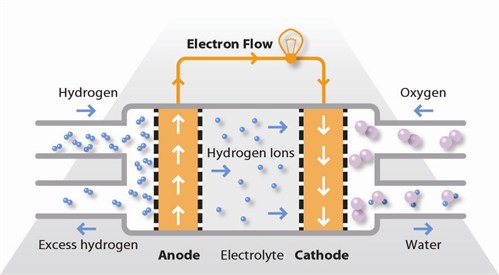Technologies
Proton Exchange Membrane Fuel Cell
The proton exchange membrane fuel cell (PEMFC) uses a water-based, acidic polymer membrane as its electrolyte, with platinum-based electrodes. PEMFC cells operate at relatively low temperatures (below 100 degrees Celsius) and can tailor electrical output to meet dynamic power requirements. Due to the relatively low temperatures and the use of precious metal-based electrodes, these cells must operate on pure hydrogen. PEMFC cells are currently the leading technology for light-duty vehicles and materials handling vehicles, and to a lesser extent for stationary and other applications. The PEMFC fuel cell is also sometimes called a polymer electrolyte membrane fuel cell (also PEMFC).

Hydrogen fuel is processed at the anode where electrons are separated from protons on the surface of a platinum-based catalyst. The protons pass through the membrane to the cathode side of the cell while the electrons travel in an external circuit, generating the electrical output of the cell. On the cathode side, another precious metal electrode combines the protons and electrons with oxygen to produce water, which is expelled as the only waste product; oxygen can be provided in a purified form, or extracted at the electrode directly from the air.
A variant of the PEMFC which operates at elevated temperatures is known as the high-temperature PEMFC (HT PEMFC). By changing the electrolyte from being water-based to a mineral acid-based system, HT PEMFCs can operate up to 200 degrees Celsius. This overcomes some of the current limitations with regard to fuel purity with HT PEMFCs able to process reformate containing small quantities of Carbon Monoxide (CO). The balance of plant can also be simplified through elimination of the humidifier.
HT PEMFCs are not superior to low-temperature PEMFCs; both technologies find niches where their benefits are preferable. The table below summarises differences between the two PEMFC variants:
|
|
Low Temp. PEMFC |
High Temp. PEMFC |
|
Operating temperature |
80-100 degrees C |
Up to 200 degrees C |
|
Electrolyte |
Water-based |
Mineral acid-based |
|
Pt loading |
0.2-0.8 mg/cm2 |
1.0-2.0 mg/cm2 |
|
CO tolerance |
<50 parts per million |
1 - 5 % by Volume |
|
Other impurity tolerance |
Low |
Higher |
|
Power density |
Higher |
Lower |
|
Cold start? |
Yes |
No |
|
Water management |
Complex |
None |
Other types of fuel cell technologies available:









